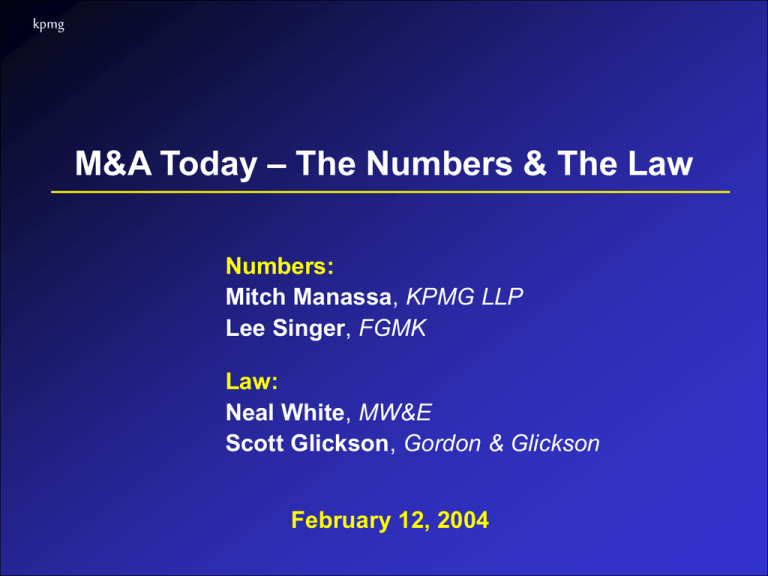View the combined presentations.
advertisement

kpmg M&A Today – The Numbers & The Law Numbers: Mitch Manassa, KPMG LLP Lee Singer, FGMK Law: Neal White, MW&E Scott Glickson, Gordon & Glickson February 12, 2004 THE NUMBERS kpmg Sarbanes-Oxley 404 Revenue Recognition Purchase Price Allocation Normalization of Financial Statements Off-Balance Pitfalls SARBANES-OXLEY 404 kpmg Effective dates Due diligence considerations Acquisition/Merger considerations Seller pitfalls Private equity RESTATEMENTS IN RECENT YEARS One third of all restatements were attributed to revenue recognition issues Main Reasons Sales contingencies not disclosed to IPR&D accounting or management Other 6% Sales booked before delivery 17% Acquisition completed 4% Revenue Significant rights of return existed Loan loss 33% Software revenue recognized before 9% underlying services were performed Cost Revenue False sales agreements and & cost 28% 3% documentation “Bill and hold” sales not deferred Source: Financial Executive Research Foundation kpmg REVENUE RECOGNITION kpmg Relevant guidance for technology firms Complexities in revenue recognition Due diligence considerations ACCOUNTING GUIDANCE What are the rules? Basic principles under SAB 101: – Persuasive evidence – Delivery – Fixed and determinable payment terms – Collectibility Other recognition “areas”: – Percentage of completion – Completed contract – Installment sales – Upfront fees kpmg Transaction considerations: Maintenance & service contracts Multiple/bundled elements Distributor/reseller agreements Customer contracts are key Bill and hold transactions Side agreements Extended payment terms Customizing or installation Price determination agreements REVENUE ANALYSIS kpmg Categorize customers as many ways as possible: – End users, resellers, distributors, or related parties; – Customers by product or service; – Customers by industry; – Customers by geography; and – One-time verses recurring. Understand the unique contractual arrangements that exist for each type of customer such as: – Milestone completion; – Rights of approval/return; and – Cancellation clauses. PURCHASE PRICE ALLOCATION kpmg Identifiable intangible assets IPR&D Goodwill (remainder) Post-merger amortization Valuations NORMALIZATION OF FINANCIAL STATEMENTS PURPOSE To remove excess charges or credits in the financial statements; adjusting the financial statements to conform with GAAP and recasting the financial statements to anticipate the major changes that will effect the business after merger or acquisition has been completed PURPOSE What prior operations might have looked like under normal conditions and on a consistent basis; or What prospective buyers might reasonably be expected to obtain from the company in the future using history as a guide. COMMON NORMALIZATION ADJUSTMENTS Balance Sheet Adjustments Income Statement Adjustments Other BALANCE SHEET ADJUSTMENTS Non operating assets, excess assets and asset shortages Loans to/from related parties INCOME STATEMENT ADJUSTMENTS Compensation of owner or family members Fringe benefits Non-recurring income and expenses Income and expenses related to excess assets, non-operating assets and asset shortages Related party revenues and expenses OTHER Non cash items Corporate cost allocations Income taxes OFF-BALANCE SHEET PITFALLS PURPOSE Amounts that are not typically booked in a GAAP financial statement, but may have a major effect on forecasted earnings; and To alert a prospective buyer about monetary amounts that may have a material effect on financial performance. TYPICAL OFF-BALANCE SHEET PITFALLS Warranty obligations (Fin 45, 46) Related party guarantees Lease commitments Maintenance contracts Purchase agreements Deferred taxes Shelf life of product Income, sales and use tax audits Non compete agreements Product liability The Law – A Mock Negotiation Law: Neal White, McDermott, Will & Emery Scott Glickson, Gordon & Glickson THE DEAL The Company - $200 Million Revenue manufacturer of wireless video wristwatch email web-browser solar powered telephone Has been S-Corporation for more than 10 years Founder/CEO owns 75% on fully diluted basis, 25% represented in minority investors and employees Founder has guaranteed company obligations on lease on manufacturing facility The Buyer – Public Company, NASDAQ Listed The Proposed Price -$50 Million in public company stock and cash Hart Scott Rodino Notification Required THE ISSUES THAT THE PARTIES WANT TO RESOLVE IN THE TERMS SHEET BEFORE PROCEEDING Asset vs. Stock deal (parties have determined it is neutral from tax perspective) Representation and warranty regarding no infringement of third party rights by the product technology Representation and warranty regarding steps taken to protect trade secrets and other confidential information Representation and warranty of accuracy of all information provided in due diligence and that everything relevant has been disclosed THE ISSUES THAT THE PARTIES WANT TO RESOLVE IN THE TERMS SHEET BEFORE PROCEEDING Purchaser’s right to walk for material adverse change Founder’s condition that his lease guaranty be released at closing Limitations on liability 1. Statute of Limitations 2. Cap on Liability 3. Basket For Immaterial Claims 4. Joint and several liability of sellers INTELLECTUAL PROPERTY REP Seller owns and possesses or has the right to use under a valid and enforceable license, sublicense, agreement or permission all Intellectual Property constituting Purchased Assets. Each item of Intellectual Property included in the Purchased Assets will be owned or available for use by Purchaser upon the Closing on terms and conditions identical to those that Seller enjoys immediately before the Closing, Seller has not interfered with, infringed upon or misappropriated any Intellectual Property rights of third parties as a result of its use of the Purchased Assets, INTELLECTUAL PROPERTY REP All persons creating any Intellectual Property as employees or contractors have assigned all rights therein to the Company Seller has never agreed to indemnify any Person for or against any interference, infringement or misappropriation with respect to the item, except pursuant to ordinary course sales supply contracts with customers; Seller has taken all necessary action to preserve and protect all Intellectual Property BUYER’S AND SELLER’S CONDITIONS Material Adverse Change It shall be a condition to Purchaser’s obligation to close that there shall have been no material adverse change in the financial condition, business, assets or prospects in the Company, whether Company specific or related to general industry or economic trends, Release of Guaranty It shall be a condition to Sellers’ obligation to close that Founder shall have been released from his lease guaranty. ACCURACY OF INFORMATION All information which has been provided to Purchaser by or on behalf of the Sellers is true and complete and no material fact has been omitted therefrom which would make such information misleading. Sellers has made or caused to be made reasonable inquiry with respect to each covenant, agreement, obligation, representation and warranty of Sellers contained in this Agreement and none of the aforesaid covenants, agreements, obligations, representations or warranties contains any untrue statement of a material fact or omits to state a material fact necessary to make such covenant, agreement, obligation, representation or warranty not misleading. Sellers have disclosed to Purchaser all information that Purchaser could reasonably determine to be material to its acquisition of the Company. INDEMNIFICATION THRESHOLD & CAP No amount will be payable by the Sellers in indemnification unless and until the Damages exceed $10,000 in the aggregate. However, this threshold limitation does not apply to any breach of any of Sellers’ representations and warranties of which Sellers had knowledge at any time before the date on which such representation or warranty was made, or (d) any intentional breach by Seller of any covenant or obligation (If the aggregate amount of all Damages exceeds $10,000 then the Sellers shall be jointly and severally for all of the Damages from the first dollar. Seller’s maximum liability under this Agreement is the purchase price.





